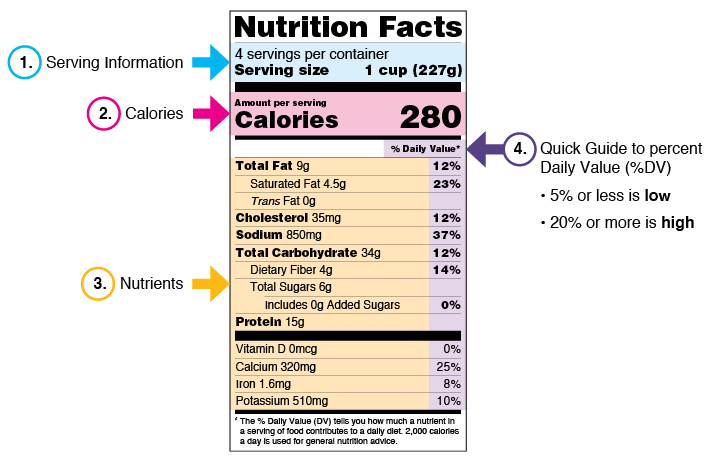
Serving Size
You don’t necessarily need to limit your intake to the serving size listed. That’s because your personal portion depends on the food, your individual needs, and how hungry you feel. But it is important to know that all of the Nutrition Facts info listed is based on the serving size. If you eat more or less than the serving stated, you can apply the difference to the numbers. For example, if the serving size is 1 slice of bread and you eat 2 slices, you’re eating twice the number of calories, protein, fiber, etc. listed on the label.
In highly processed foods, it can be eye-opening to see just how much-saturated fat, cholesterol, added sugar, and sodium one serving packs. Compared with whole food, it’s easy to rack up many calories without even feeling full. For example, a medium apple provides about 125 calories, 5 grams of fiber, and no added sugar, whereas just 7 gummy fish candies contain 150 calories, no fiber, and 8 teaspoons worth of added sugar.
Calories
Love.Life does not recommend counting calories. We believe in eating a primarily whole food plant-based diet and tuning into hunger and fullness cues to guide portions. However, on packaged foods, calorie information can be helpful for comparing different foods to each other or noting the calorie content of a food in relation to its serving size. The latter is referred to as calorie density.
A label can also help you determine a packaged food’s nutrient density, or how much nutrients it contains per serving.
A food with a high number of calories and low amount of nutrients per serving is often referred to as an empty-calorie food.
As you transition to a whole food plant-based diet, you may continue to eat some highly processed foods from time to time.
Assessing label information may help you find better-for-you options within a specific category, like a crunchy snack or dessert. Or perhaps you’ll opt for a less processed alternative, such as baked sweet potato wedges over fried sweet potato chips.
But we recognize that life happens, and celebrations and holidays often include traditional or favorite foods, and that’s OK. The consistency of your overall eating pattern is much more important and impactful than any one food.
What are Daily Values?
Below you’ll see references to Daily Values or %DV. These percentages represent how much one serving of a food provides for a particular nutrient (such as fiber or sodium) compared to the average recommended target or limit per day.
The percentage is based on a 2000-calorie-per-day diet, which may be more or less than your individual nutrition needs.
Fat
Saturated fats are solid at room temperature. At Love.Life we recommend limiting saturated fat because of its relationship with heart disease. The USDA recommends that less than 10% of your daily calories come from saturated fat. When you look at the nutrition label, opt for foods with a Daily Value or %DV for saturated fat that is 10% or less.
We recommend avoiding trans-fat altogether due to its negative effects on cholesterol and heart health. On a nutrition facts label, the trans-fat content should be 0g. Trans fat has been generally eliminated from our food system, but there are some hidden sources to be aware of.
To find hidden trans fats, you must look at a food’s ingredient list.
Under ingredients if you see “partially hydrogenated oils” of any sort, there are hidden trans fats in the food. While the amount may not be enough to add up to 1 gram or more per serving, the presence of trans fat can negatively impact your health, particularly if you eat several servings of that food or eat it often.
Sometimes, you will see “fully hydrogenated oils” on the food label. While these are not technically trans fats, they are highly processed oils that act like saturated fats in your body and may harm your health. Avoid them whenever possible.
Unsaturated fat is listed on the food label as monounsaturated and polyunsaturated fat. These fats are beneficial health wise. You’ll find them in nuts and seeds, extra virgin olive oil, or canned wild salmon.
Sodium
Consuming sodium in moderation is an important way to prevent or control high blood pressure.
Look at the %DV for sodium to put a packaged food in perspective in relation to your overall daily sodium intake. For example, if one serving of food provides 25% of the DV for sodium, you have “used up” a quarter of the daily recommended sodium limit. Every food you eat doesn’t need to be low in sodium, but you shouldn’t exceed 100% of the Daily Value per day.
When looking at sodium on a nutrition label, Love.Life aims for a 1:1 ratio meaning the milligrams of sodium should be less than or equal to the calories per serving. For example, if a serving size is one slice of bread that contains 100 calories, the sodium content should be no more than 100mg, give or take. That said, some healthful whole food products may exceed this 1:1 ratio. If so, here are a few things to consider:
Does the whole food product provide important nutrients, such as whole grains, protein, or fiber? For example, 1 cup of beets provides about 60 calories but 100mg of sodium. While this is not within the recommended 1:1 ratio, beets supply fiber and phytonutrients with known benefits for reducing blood pressure. In comparison, a 1/2 cup serving of canned chicken noodle soup may contain 60 calories and about 890mg of sodium. While both beets and chicken noodle soup are outside of the 1:1 ratio of calories per serving to sodium milligrams, beets have much less sodium and provide substantially more nutritional benefits.
Is the sodium DV% still within a reasonable range? Generally speaking, a “low sodium” food provides 5% or less of the DV per serving. But foods that are less than 10% DV for sodium or under 25% can still be part of a well-balanced nutrition plan. Consider the other food items you consume that day. If one is high but the majority are very low, your sodium intake will average out to a low intake overall. You don’t need to be perfect; just work towards being conscious of your sodium intake and try to consistently maintain healthful habits.
Processed products often contain a high amount of sodium to flavor and preserve the food.
The highest sodium contributors in a typical American diet are bread items, pizzas, sandwiches and cold cuts, soups, burritos and tacos, salty snacks, chicken, cheeses, and eggs and omelets. Seasoning mixes and condiments can also be quite high.
Don’t forget to consider how the numbers can add up. For example, if a 1-cup serving of soup provides 600mg of sodium or 26% of the DV and you eat 2 cups, you’ve hit more than 50% of the daily limit. If you eat that soup with a grilled cheese sandwich made with 2 slices of bread and a slice of processed cheese, you can easily exceed the %DV for sodium for the day in just a single meal.
Carbohydrates
Carbohydrates are a crucial source of energy for your body, especially your brain and muscles. We recommend meeting your carbohydrate needs through whole food sources over highly processed products. Good options include whole grains, vegetables, fruits, and legumes.
At Love.Life we do not recommend “carb counting” but we generally advise covering about a quarter of your plate with starchy whole-food carbohydrates. Overall, for every 25g of carbohydrates, you should consume at least 3-5g of fiber. If you eat whole-food carbohydrates, this will occur naturally.
Dietary Fiber
Fiber helps promote healthy bowel movements, improves satiety, helps regulate blood glucose or blood sugar levels, and supports weight management. Fiber is naturally found in plant foods and may be added to processed foods.
The general recommendation for fiber is ~25g per day for women and ~38g for men. But experts suggest that diets with closer to 40g of fiber per day are better for health.
You can use the nutrition label to assess the grams of fiber per serving size.
Fiber is the one nutrient for which we encourage you to exceed the %DV. That said, we recommend getting fiber from naturally occurring sources, such as whole grains and beans, over-processed products with fiber added, like energy bars.
Also, be sure to drink plenty of water as you increase your fiber intake, as water is needed to help your digestive system properly handle the fiber.
Sugar
Sugar is naturally occurring in many whole, nutrient rich plant-based foods, so the goal is not to avoid sugar completely. However, it is important to limit added sugar, the type added to food by the manufacturer to sweeten a product or the kind you add yourself, like stirring sugar into your coffee or tea.
Eating more whole, unprocessed foods is a great way to automatically reduce your added sugar intake. For example, fresh fruit and nuts provide no added sugar while a processed granola bar may provide a few teaspoons worth.
Added sweeteners found in packaged foods may include high fructose corn syrup, dextrose, cane sugar, honey, or agave, to name a few. And while sweeteners such as cane sugar, honey, and maple syrup are natural, they still count as added sugar and should be limited.
The American Heart Association recommends that women limit added sugar to no more than 24 grams per day for women and men no more than 36 grams per day. You’ll find the grams of added sugar per serving listed on the nutrition label.
When possible, we recommend buying unsweetened foods and adding sweetness in the form of other whole foods, such as whole fruit. For example, prepackaged oatmeal may use cane sugar as a sweetener and can contain 8 grams of added sugar per packet. We prefer starting with plain rolled oats and adding in mashed banana or minced dates and cinnamon to provide natural sweetness from whole foods.
By using naturally occurring sugar from fruit to sweeten foods, you add fiber and nutrients and align meals with a whole food plant-based diet approach.
Protein
Protein is often the first concern when going plant-based, but protein is found in many plant foods.
Most people require 0.8g of protein per kg of their body weight, although you may need more based on your age, physical activity level, and goals. For a 150-pound adult 0.8 g per kg is about 55 g of protein per day or roughly 15-18 grams 3 times per day.
It’s important to eat a variety of plant-based foods in order to take in a wide array of amino acids, the building blocks of protein. While all plant foods provide all 9 essential amino acids, the amount of a particular amino acid may be low in one type of plant food and high in others. When you eat foods from different food groups throughout the day, including vegetables, whole grains, legumes, nuts, and seeds, you take in many different amino acids. These amino acids come together to form complete proteins that your body can use to maintain, heal, and repair protein tissues, including muscle.
Vitamins and Minerals
The nutrition label traditionally includes Daily Values for vitamin D, calcium, iron, and potassium.
Do not be turned off by a product with low values for any of these nutrients. All whole foods bring something different to the table, and as you diversify your diet with as many plants as possible, you will naturally diversify your intake of vitamins and minerals.
In addition, some foods may be low in vitamins and minerals but rich in antioxidants or other health-protective compounds.
That said, there are some vitamins and minerals that are more difficult to obtain from a plant-based diet.
Ingredients
It’s important to easily recognize all the ingredients in a packaged food. The best rule of thumb is to look for products with common plant-based ingredients free from additives like sweeteners, preservatives, flavors, colors, and oils.
If you’re trying to eat a plant-based diet, reading the ingredient list can help you find hidden sources of animal-based ingredients.
For example, by reading the ingredient list you may find that a soup or can of beans was made with lard, or that a sauce contains eggs or milk.
Become a food label sleuth!
Look for terms like roasted, seasoned, or flavored on packages of nuts, seeds, or legumes, which may indicate that sugar or salt has been added. Monitor your condiments and sauces for their levels of sodium, added sugar, and processed ingredients. You may be surprised by how much-added sugar you’ll find in ketchup or barbecue sauces, in addition to food dyes in hot sauces or chili pastes, and added oils in jarred pasta, pizza, or curry sauces.

